|
Battle of Allatoona, Georgia
| Civil War Georgia Map |
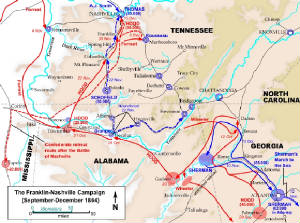
|
| Georgia Civil War History Map |
Other Names: Battle of Allatoona Pass
Location: Bartow County
Campaign: Franklin-Nashville Campaign (1864)
Date(s): October 5, 1864
Principal Commanders: Brig. Gen. John M. Corse [US]; Maj. Gen.
Samuel G. French [CS]
Forces Engaged: One brigade (1,944 men) [US]; one division (approx.
2,000 men) [CS]
Estimated Casualties: 1,505 total (US 706; CS 799)[1]
Result(s): Union victory
| Battle of Allatoona, Georgia, Map |
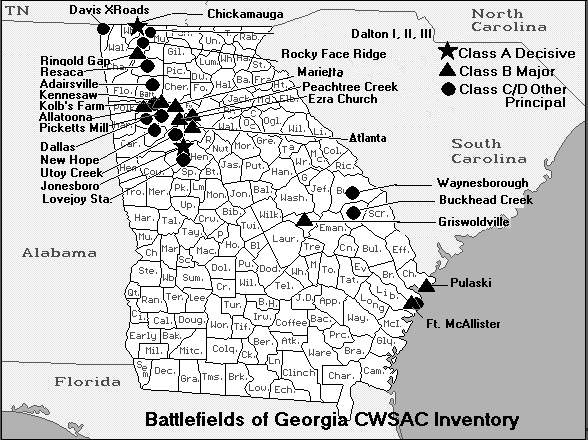
|
| Civil War Allatoona Battlefield Map |
Description: After the
fall of Atlanta (see Battle of Atlanta : Atlanta Campaign History Homepage), Hood moved northward to threaten the Western & Atlantic Railroad,
Sherman’s supply line. He attacked a number of minor garrisons and damaged track during October 2-4. Sherman sent reinforcements—John
M. Corse’s brigade—to Allatoona just before the Rebels attacked there. Maj. Gen. Samuel G. French’s
Confederate division arrived near Allatoona at sunrise on the 5th. After demanding a surrender and receiving a negative reply,
French attacked. The Union outer line survived a sustained two and a half hour attack, but then fell back and regrouped in
an earthen “Star” fort of Allatoona Pass. French repeatedly attacked, but the fort held. The Rebels began to run
out of ammunition, and reports of arriving Union reinforcements influenced them to withdrawal and rejoin Hood’s force.
Of note was the second bloodiest battle of the entire Civil War that was
fought at Chickamauga, Georgia, September 18-20, 1863. Opposing commanders were Confederate General
Braxton Bragg and Union General William Rosecrans. Total Confederate Forces Engaged: 66,326; Total Union Forces Engaged: 58,222.
Total Casualties: 34,624 (16,170 Union and 18,454 Confederate). Result: Confederate Victory.
| Georgia Civil War Marker |
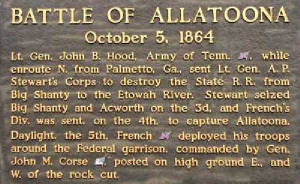
|
| Civil War Georgia Battle Marker |
| Georgia Civil War History |
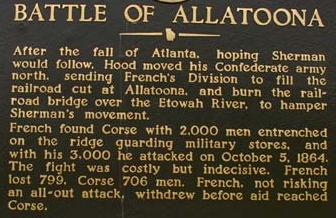
|
| Civil War Georgia Battlefield History |
Background: After the fall of Atlanta, Lt. Gen. John Bell
Hood moved the Confederate Army of Tennessee northward to threaten the Western and Atlantic Railroad, Maj. Gen. William T.
Sherman's supply line. Hood's corps under Lt. Gen. Alexander P. Stewart attacked a number of minor garrisons and damaged track
from October 2 to October 4. Hood ordered Stewart to send a division to attack the Federal supply base where the railroad
ran through a deep gap in the Allatoona Mountain range and then move north to burn the bridge over the Etowah River. At Hood's
suggestion, Stewart selected the division of Maj. Gen. Samuel G. French, three brigades commanded by Brig. Gens. Claudius
Sears, Francis M. Cockrell, and William Hugh Young.
The small Federal garrison, commanded by Col. John Eaton Tourtellotte, was
a partial brigade (1st Brigade, 3rd Division, XV Corps, consisting of the 93rd Illinois Infantry, 18th Wisconsin Infantry,
and Tourtellotte's own 4th Minnesota Infantry. Before the Southern division arrived, Sherman sent a reinforcement brigade
(3rd Brigade, 4th Division, XV Corps) to Allatoona, under the division commander, Brig. Gen. John M. Corse, who took command
of both brigades. The Federal troops occupied strong defensive positions in two earthen redoubts on each side of a 180 feet
(55 m), 65 feet (20 m) deep railroad cut and many of the men, including the entire 7th Illinois, were armed with Henry repeating
rifles.
| Georgia American Civil War |
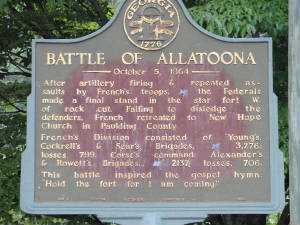
|
| Civil War Georgia History |
Battle: French's division arrived near Allatoona at sunrise
on October 5. After a two-hour artillery bombardment by Captain Alcide Bouanchaud's four-gun Pointe Coupee Artillery, French
sent a demand for surrender, which Corse refused. French then launched his brigades in an attack—Sears from the north
(against the rear of the fortifications) and Cockrell, supported by Young, from the west. Corse's men survived the sustained
two-hour attack against the main fortification, the Star Fort on the western side of the railroad cut, but were pinned down
and Tourtellotte sent reinforcements from the eastern fort. Under heavy pressure, it seemed inevitable that the Federals would
be forced to surrender, but by noon French received a false report from his cavalry that a strong Union force was approaching
from Acworth, so he reluctantly withdrew at 2 p.m.
| Georgia American Civil War History |
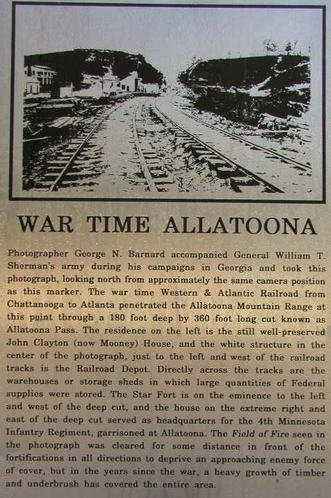
|
| Georgia and the Civil War |
| Georgia Civil War Battle |
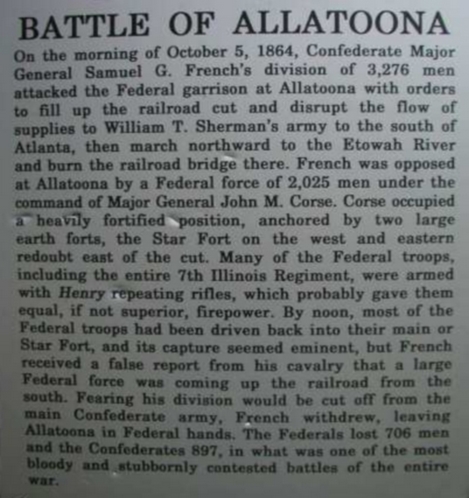
|
| Civil War Georgia History |
Aftermath: Allatoona was a relatively small, but
bloody battle with high percentages of casualties: 706 Union (including about 200 prisoners) and 897 Confederate[2]. Corse
was wounded during the battle and on the following day sent a message to Sherman: "I am short a cheek bone and one ear, but
am able to lick all hell yet." French was unsuccessful in seizing the railroad cut and Federal garrison, regretting in particular
that he was unable to seize the one million rations stored there, or to burn them before he retreated.
| Georgia and the Civil War Battlefield Map |
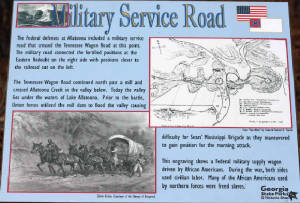
|
| American Civil War Georgia Battle Map |
| Allatoona Pass, Georgia Civil War Battlefield Map |
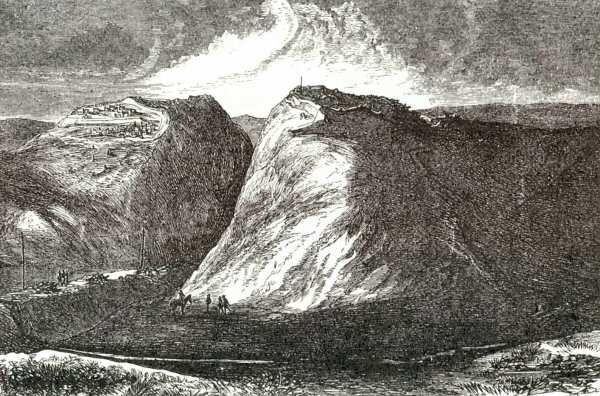
|
| Wartime Image by Harper's Weekly |
There is a persistent myth that Sherman signaled the garrison to "hold the
fort" while reinforcements were rushing to their relief, and that intercepting this signal may have been a factor in causing
the Confederates to withdraw. Sherman denied the story and in fact the relief column under Maj. Gen. Jacob D. Cox did not
arrive until two days after the battle. Nevertheless, the quotation "hold the fort" is attributed to Sherman. The most likely
source of the quotation was a hymn entitled Hold the Fort by Chicago evangelist Philip P. Bliss, which featured the chorus,
"Hold the fort; for we are coming, Union men be strong."
| Georgia Civil War Confederate Map |
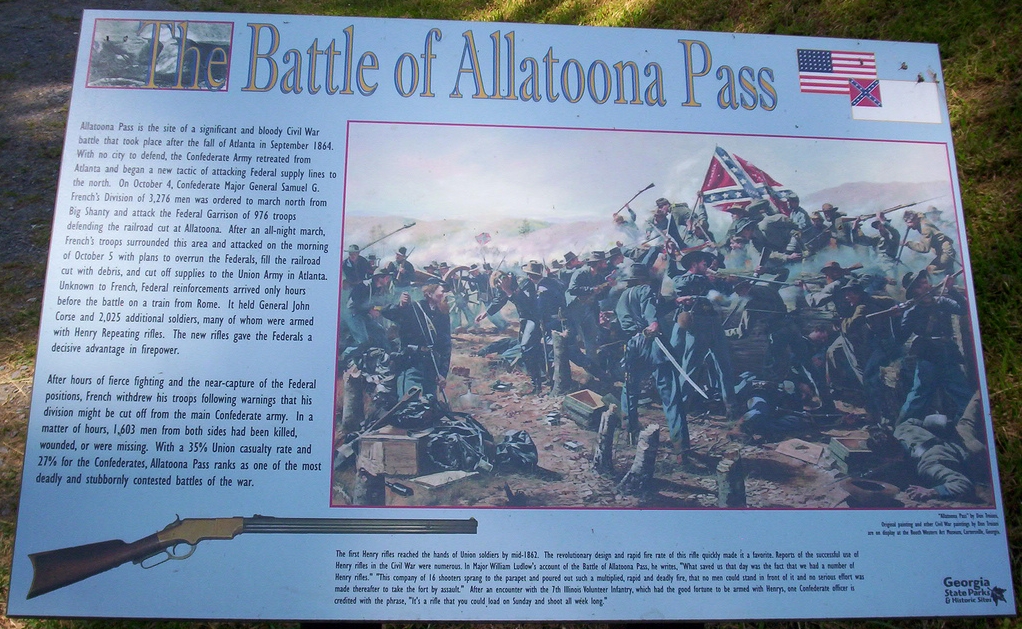
|
| Confederate Georgia Map |
*Georgia Civil War History: On January 18, 1861, Georgia seceded from the Union during the American Civil War but kept the name
"State of Georgia", and joined the newly formed Confederacy in February. During the war, Georgia sent nearly 100,000 soldiers
to battle, mostly to the armies in Virginia. The state switched from cotton to food production, but severe transportation
difficulties eventually restricted supplies. Early in the war, the state's 1,400 miles of railroad tracks provided a frequently
used means of moving supplies and men but, by the middle of 1864, much of these
lay in ruins or in Union hands.
The Georgia legislature voted $100,000 to be sent to South Carolina for
the relief of Charlestonians who suffered a disastrous fire in December 1861.
Thinking the state safe from invasion, the Confederates built several small
munitions factories in Georgia, as well as housing tens of thousands of Union prisoners. Their largest prisoner of war camp,
at Andersonville, proved a death camp because of severe lack of supplies, food, water, and medicine.
Georgia was relatively free from war until late 1863. A total of nearly
550 battles and skirmishes occurred within the state, with the vast majority in the last two years of the conflict. The first
major battle in Georgia was a Confederate victory at the Battle of Chickamauga in 1863—it was the last major Confederate
victory in the west. In 1864 William T. Sherman's armies invaded Georgia as part of the Atlanta Campaign. Confederate general
Joseph E. Johnston fought a series of delaying battles, the largest being the Battle of Kennesaw Mountain, trying to delay
Union armies for as long as possible as he retreated toward Atlanta. Johnston's replacement, Gen. John Bell Hood, attempted
several unsuccessful counterattacks at the Battle of Peachtree Creek and the Battle of Atlanta, but Sherman captured Atlanta
on September 2, 1864.
| Georgia Civil War Map |
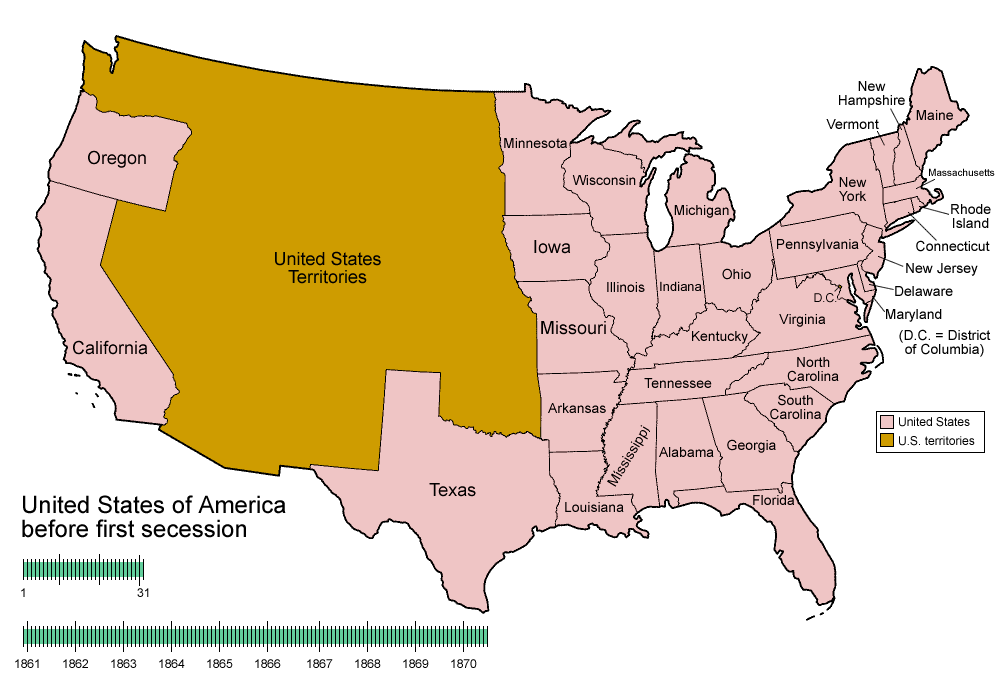
|
| Georgia Civil War Timeline Map |
After Sherman's March to the Sea, he delivered the final blow to the
Confederacy during the Campaign of the Carolinas (also known as Sherman's March from the Sea).
After burning Atlanta to the ground, Sherman embarked on his March
to the Sea on November 15, en route to Milledgeville, the state capital, which he reached on November 23, and the port city
of Savannah, which he entered on December 22. A swath of land about 60 miles across was destroyed in this campaign, somewhat
less than 10% of the state. Once Sherman's army had passed through the Confederates regained control. The March is a major
part of the state's folk history, and is the setting for Margaret Mitchell's 1936 novel Gone with the Wind and subsequent
1939 film. In December 1864, Sherman captured Savannah before leaving
Georgia in January 1865 to begin his Carolinas Campaign.
Lee surrendered to Grant on April 9, 1865, Lincoln was assassinated
on April 14, and the last major Confederate Army, commanded by Johnston, with the conclusion of the Campaign of the Carolinas, surrendered to Sherman at Bentonville, North Carolina, on April 26. Reconstruction followed. See also Georgia Civil War History.
| Atlanta Civil War Map |
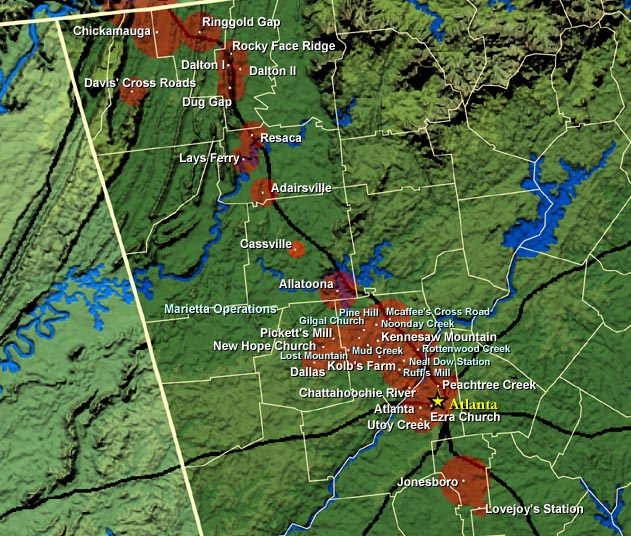
|
| Greater Atlanta Civil War Map |
| Sherman March to the Sea Map |
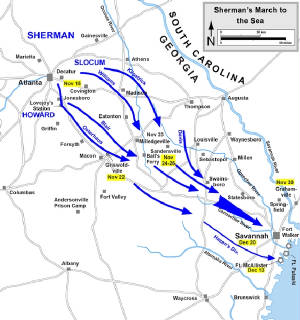
|
| Georgia Civil War History Map |
| Georgia Civil War History Map |
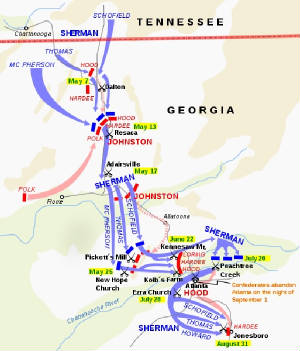
|
| Atlanta Campaign Map |
Analysis: During the war, Georgia sent thousands
of soldiers to battle, mostly to the armies in Virginia. The state switched from cotton to food production, but severe transportation
difficulties because of underdeveloped roads and railroads restricted movement of supplies. Thinking the state safe from invasion,
the Confederates built small munitions factories.
The first major battle in Georgia was a Confederate victory at the Battle
of Chickamauga in 1863—it was the last major Confederate victory in the west. In 1864, William T. Sherman's armies invaded
Georgia as part of the Atlanta Campaign. Confederate general Joseph E. Johnston fought a series of delaying battles, the largest
being the Battle of Kennesaw Mountain, as he tried to delay as long as possible by retreating toward Atlanta. Johnston's replacement,
Gen. John Bell Hood attempted several unsuccessful counterattacks at the Battle of Peachtree Creek and the Battle of Atlanta,
but Sherman captured the city on September 2, 1864. After the loss of
Atlanta, Governor Brown withdrew the state's militia from the Confederate forces to harvest crops for the state and the army.
After burning Atlanta to the ground, Sherman embarked on his March to the
Sea on November 15, en route to Milledgeville, the state capital, which he reached on November 23, and the port city of Savannah,
which he entered on December 22. His army destroyed a swath of land about 60 miles (97 km) across in this campaign, less than
10% of the state. Once Sherman's army passed through, the Confederates regained control.
The war left parts of Georgia devastated and the state's economy in shambles.
Reconstruction activities started immediately after the hostilities ceased, but lingering effects of the bitter strife continued
into the 20th century. Reconstruction was marred with the memory of Total War, or Hard War, implemented by Sherman. To date,
Sherman remains the center of heated debate and controversy. Georgia did not re-enter the Union until June 15, 1870, more
than two years after South Carolina was readmitted. Georgia was the last of the Confederate States to re-enter the Union.
[1] National Park Service.
[2] Kennedy, p. 391.
(Sources and related reading at bottom of page.)
Advance to:
Sources: National Park Service; Evans, Clement A., ed. Confederate Military
History: A Library of Confederate States History. 12 vols. Atlanta: Confederate Publishing Company, 1899. OCLC 833588; Jacobson,
Eric A., and Richard A. Rupp. For Cause & for Country: A Study of the Affair at Spring Hill and the Battle of Franklin.
O'More Publishing, 2007. ISBN 0-9717444-4-0; Kennedy, Frances H., ed. The Civil War Battlefield Guide. 2nd ed. Boston: Houghton
Mifflin Co., 1998. ISBN 0-395-74012-6; Sword, Wiley. The Confederacy's Last Hurrah: Spring Hill, Franklin, and Nashville.
Lawrence: University Press of Kansas, 1992. ISBN 0-7006-0650-5. First published with the title Embrace an Angry Wind in 1992
by HarperCollins; Welcher, Frank J. The Union Army, 1861–1865 Organization and Operations. Vol. 2, The Western Theater.
Bloomington: Indiana University Press, 1993. ISBN 0-253-36454-X.
Subjects: Georgia Civil War History, Battle of Atlanta, Sherman March Map, Battlefield, Battle of Chickamauga,
General Hood, Allatoona, Confederate Army, Campaign, Union Killed, Prisoners, Savannah, Bragg, Fort, Rosecrans, Battle of
Adairsville, Battle of Allatoona, Battle and Campaign of Atlanta, Battle of Brown's Mill, Battle of Buck Head Creek, Battle
of Chickamauga, Battle of Dallas, Battle of Dalton I, Battle of Dalton II, Battle of Davis' Cross-Roads (Crossroads), Battle
of Ezra Church, Battle of Fort McAllister I, Battle of Fort McAllister II, Battle of Fort Pulaski, Battle of Griswoldville,
Andersonville Prisoner of War Camp, Battle of Jonesborough, Battle of Kennesaw Mountain, Battle of Kolb's Farm, Battle of
Lovejoy's Station, Battle of Marietta [Operations], Battle of New Hope Church, Battle of Peachtree Creek, Battle of Pickett's
Mill, Battle of Resaca, Battle of Ringgold Gap, Battle of Rocky Face Ridge, Battle of Utoy Creek, Battle of Waynesborough.
|

